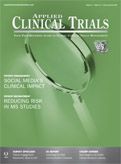Dermatology Biologics: Overcoming Challenges to Fulfill Therapeutic Potential
Applied Clinical Trials
To vie for success in the market for dermatologic therapies, companies developing biologics must navigate a series of significant challenges, including patient compliance and safety.
Biologics have gained a foothold in dermatology, and growth in this area has been fueled by improving clinical outcomes. The dermatology market is expected to grow to $33.7 billion by 2022, and 37% of drugs currently in the pipeline in this segment are biologics, according to a 2016 report by GBI Research. These drugs, as well as recently approved products, address such conditions as moderate-to-severe plaque psoriasis, atopic dermatitis, hidradenitis suppurativa, urticaria, and alopecia areata. To be a prominent player in the market for dermatologic therapies, companies developing biologics must successfully navigate a series of significant challenges, including patient compliance, medication costs, and patient safety.
Darcee Strube

Compliance
Biologics are typically a third-line treatment option for patients who have not responded sufficiently to topicals and/or phototherapy. However, issues with patient compliance may prevent patients from receiving the full benefits of therapy. Patient compliance is impacted by how drug regimens are administered, e.g., a self-administered injection vs. in-clinic intravenous infusions. Frequency, dosage, need for monitoring, and safety concerns can also influence overall compliance. Noncompliance with treatment regimens may lead to adverse effects such as the formation of anti-drug antibodies. To help ensure patient compliance for dermatology treatments, patient advocacy groups recommend a focus on goal setting. The National Psoriasis Foundation’s “Treat 2 Target” program provides a set of treatment goals for patients to use with their providers. The goals, published online in the Journal of the American Academy of Dermatology in November 2016, include doctor visits at three and six months after initial diagnosis or the start of new treatment to monitor progress with a target of 1% or less of psoriasis covering the body.
Quality of life vs. medication costs
Biologics can be more effective than topical therapies because they address underlying disease and inflammatory mechanisms rather than merely the symptoms. This has led to noteworthy improvements in patient outcomes, as outlined in a 2014 study which examined quality of life and mental health in psoriasis patients comparing biologic treatments to other modalities. The study concluded that patients treated with biologics saw a 52.2% decrease in General Health Questionnaire (GHQ-30) scores, as compared to a 24% and 17% decrease among systemic and topical treatments, respectively. This data suggests biologics may lead to better outcomes for some psoriasis patients. Valeant Pharmaceutical’s brodalumab (Siliq) is reportedly the first product to demonstrate 100% improvement in the psoriasis area and severity index (PASI 100) as a primary endpoint in clinical trials. Furthermore, biologics have the potential to improve patient quality of life beyond the treatment paradigm, including lower levels of anxiety, social dysfunction, sleep disturbance, and somatic symptoms.
However, the cost of biologics is rising, and they are typically more expensive than oral systemic therapies. Yet there is some positive news: A study published in the British Journal of Dermatology found biologics that treat moderate-to-severe plaque psoriasis reduce costs associated with major changes in the pattern of healthcare delivery, reduce the number of inpatient admissions by more than half, and reduce the mean number of inpatient days by more than 75%.
Safety
Due to rare but potentially serious side effects, patient safety is a major consideration in biologics trials compared to studies of other dermatologic agents. Now, the level of oversight is greater, safety monitoring is more frequent, and safety teams, usually small for dermatology studies, have become much larger. In clinical trials, detailed inclusion/exclusion criteria are strictly enforced to protect patients. While further research is needed, dermatology patients and physicians still welcome the overall benefits and safety profiles of biologic treatments. Patients are experiencing greater skin clearance and quality of life than ever before.
Darcee Strube is Senior Vice President, Dermatology Division, at Novella Clinical.
